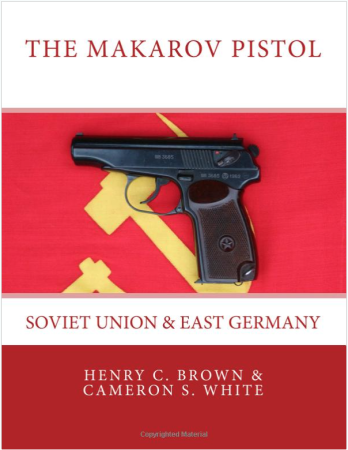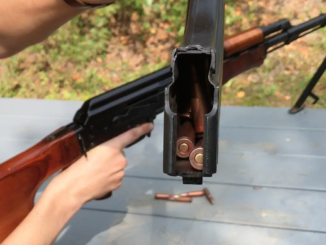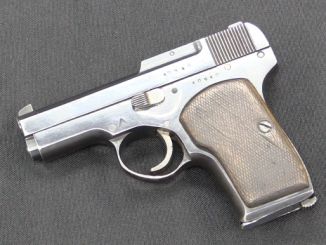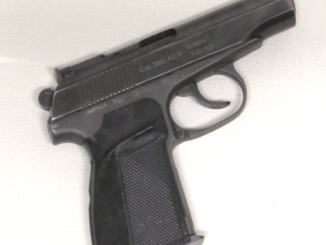Until recently, the only good reference book on the Makarov pistol has been Volume 16 of Fred Datig’s Soviet Arms series – which is hampered by the lack of public information available to the author in the late 1980s. Well, now we have another option: Henry Brown and Cameron White’s new book “The Makarov Pistol: Soviet Union and East Germany“.
This new book is a very good collectors’ guide to the Makarov, although it definitely leaves a place open for someone to write a more comprehensive reference work on the subject. It comes to a total of 122 pages, split primarily into a section on the Soviet Makarov (written by Brown) and a section on the East German Makarov (written by White). Both sections appear to have their research based on observation of known examples of the guns, with a nice large sample size allowing for accurate inferences to be made regarding production numbers, timelines, and changes in characteristics. Eventually, someone will print a book in English based on original arsenal and military documents – but this is not that book.
It does suffer aesthetically from being clearly a self-published book. Some photos retaining background shadows and cropping, and the layout is very simplistic. None of this negatively impacts the information conveyed, however, and reducing the layout and printing costs did presumably help make the project feasible in the first place. Someone looking for a Leonardo Antaris or Collector Grade work will be disappointed, as this is more akin to Robert Adair’s book on Unique Pistols.
That said, the content is good and contains plenty of useful elements. The changes from the initial prototypes to the early production pistols and thence to the mass production and late production guns includes a number of minor part variations that are not documented elsewhere in print, and the explanation of Makarov serial number and dating schemes (to the extend they are deciphered so far) is excellent for the collector. Some of the less-standard variants are also discussed, including the Soviet PMM (double-stack modernized Makarov), Baikal export guns, and the Makarovs sold in the 90s by Suhl. Import marks are examined in some detail, especially in the East German section, which will be very helpful for tracing where different examples have been. Both sections also include looks at accessories, including ammunition, holsters, and lanyards.
Overall, the book is worth the $30 asking price for those who are interested in the topic. It has a bunch of information not found in Datig’s book, and is a great guide for the beginning collector. It is also nice to see that it is available electronically on the Kindle for $10, for those folks who prefer their media in that format.
Here is my companion video review:





Sorry for interjection, this may not relate to current piece, but it does relate to one of previous ones:
http://www.thefirearmblog.com/blog/2016/10/24/buying-selling-stg44-mp44-mp43-rifles-rebel-held-syria-lots-photos/
I hope to return to Makarov story later; it is extremely interesting one.
The book’s description on Amazon states, “This is a book by collectors, for collectors, and it is the first comprehensive collector’s review of the Makarov Pistol.”
I’m somewhat confused about how a “guide for the beginning collector” might only cover a small subset of manufacturers, presumably requiring the collector to independently verify a Makarov’s country of origin before proceeding any further.
Hopefully the introductory chapter or appendix would have a complete list of all the countries and factories where the Makarov was ever made, along with identifying markings and the telltale (as well as esoteric) physical characteristics of each, along with parts (in)compatibility issues between them.
New to Makarov collecting, and this book retails for only $30? Shut up and take my money.
MAC did presentation of Makarov recently and found it rather satisfying. For sure good collectible item.
https://www.youtube.com/watch?v=CuGm1r6APJk
I bought once surplus Makarov E.German holster and found it very well fitting on my vz.70.
My couriosity caused me to read the email … then when seeing the picture of the Makarov couldn’t help but notice that it looks a lot like my Argentina made Bersa Firestorm & Bersa Thunder pistols, recently purchased.
Does anyone have any information reference the potential that the Bersa might be a copy of the Makarov. Seems to me highly possible that the design i.e. taper from trigger to muzzle, might be considered a design copy, as opposed to an original concept. Considering that, might there be other parts copied/cloned?
Just asking. Discovered it easier to spend a couple dollars more to get a second magazine and pistol, than order and pay “big bucks” just for the magazine. The Thunder is black (metal) over stainless … and is my “Sunday gun” … comments reference the Bersa appreciated, thanks.
Bersa Thunder series might be accepted as a clone of Beretta Model “Roma” rather than Makarov. Their trigger work, take down and safety mechanism are different. IMHO.
The following reputable sources also have YouTube evaluation videos available for review regarding the 9mm Makarov pistol :
1. Sootch00 — Bulgarian and Polish Makarov’s
2. Hickok45 — Russian military and Bulgarian Makarov’s
3. Mrgunsngear — Polish P-64 version
4. Iraqveteran8888 — Russian Commercial Makarov, East German Makarov PM, Hungarian PA-63, and Czech CZ-82 variant ( with SA/DA and double-stack magazine )
5. BigDaddyHoffman1911 — Bulgarian Makarov
These are only a mere handful among numerous available reviews of Makarov variants. Virtually all agree that the 9mm Makarov pistol is generally a really simple, solidly-built, handy, accurate, controllable, ergonomically-friendly and stone-dead reliable weapon with an excellent OEM trigger and a long-proven battle / service record. And all at a price point that leaves plenty of room for ammunition, extra magazines, etc. while still keeping things affordable.
All in all, probably one of the most under-rated yet most deserving sub-compact pistols on the market today — at least here in the United States.
You don’t want to have any Makarov aimed at your head. If I know facts well, there are gas pistols based on the PM which use high quality gun steel instead of zinc. This means the usually sub-caliber tear gas gun can be bored out to 9×18 easily as opposed to the other pistols with weak aluminum or zinc barrels… or am I wrong?
Notice that change from 7.62×25 to 9×18 was serious decision, as during Great Patriotic War, many PPSh, PPS and TT pistol were produced together with ammunition for it.
“All in all, probably one of the most under-rated yet most deserving sub-compact pistols on the market today — at least here in the United States.”
Well, they have full market of .380 Auto which is equivalent of 9×18 PM cartridge in sense that is ballistic potent cartridge which can be harnessed by (simple) blow-back automatic pistol of reasonable mass.
“9mm Makarov pistol”
This is quite confusing to me, analyzing this give me ГРАУ 56-А-125, but from context it looks that you want to refer to 9×18 cartridge, for which name 9mm Makarov make no sense as it was designed by Б.В.Семин.
“sub-compact”
For small-size automatic pistol firing 9×18 see OTs-21:
http://world.guns.ru/handguns/hg/rus/oc-21-e.html
During the end of WW2 many Nazi “upper eschalon” disappeared, and in my recollection, may have migrated to Argentina. Is it possible that my recollection is correct, and in that event is it also possible that they might have gone into weapon manufacturing to earn a living …. possibly by cloning weapons they were familiar with. anyone know the history of the Bersa weapon manufacturing?
This case was not that ubiquitous “Nazi magic how to fly to Moon” (aka W.v.Braun) but work of 3 Italian immigrants.
https://en.wikipedia.org/wiki/Bersa
Yes, some ended up there; for instance well known war criminal A.Eichmann went to Argentina(and was promptly extracted), but it does not mean that all of them went there.
https://en.wikipedia.org/wiki/Adolf_Eichmann
I am always struck by the PM’s extraordinary simplification of components: on any Ruby or equivalent, there is a hammer spring, hammer strut or plug, the magazine release plug at the other end of the hammer spring, mag release and pin or other attachment to the frame, two grip panels, and two or more grip screws. On the Makarov one (very long and strangely shaped) leaf spring, one wrap-around grip, and one screw do all the same jobs, and better, with incredible savings on manufacture, assembly, and repair time. I’d like to know how Makarov thought it up.
“Makarov”
Н.Ф.Макаров was слесарь (not sure English translation in this place: fitter/locksmith/machinist?), worker of railroad, working in Сасовский район (Sasovksy District), he go to Тульский механический институт in 1936. During Great Patriotic War he was мастер of production of PPSh. Got diploma in 1944. After war he moved back to Tula, where he worked (in ЦКБ-14).
–
Also in this place is worth nothing that in Soviet Union development of 9mm blow-back automatic pistol was in progress before outbreak of war – namely ТКБ-205 by Margolin, see first image from top here:
http://www.arms.ru/Guns/tkb205.htm
Notice that it has only 23 (from factory point-of-view) parts
“any Ruby or equivalent”
Ruby automatic pistol was not developed in 1940s – is that comparison fair?
Most logical is to compare Makarov to other proposal from same competitions.
Obviously Makarov’s entry was not single one in competition for new automatic pistol.
Other challengers were:
Воеводин П.В.
Барышев К.А.
Коровин С.А.
Симонов С.Г.
Севрюгин Г.В.
Раков И.И.
Additionally notice that Makarov automatic pistol as-adopted was derived from earlier Makarov automatic pistol (see 1st photo from top in link below).
You can see designs competitive to Makarov design crafted in 1940s here:
http://shotgun.com.ua/fire/pm/pm_hist.html
I refer to the bottom and back of the frame — I suppose I could go back to the 1903 Browning — in which a multiplicity of parts powers the hammer, retains the magazine, and keeps the grips attached to the handle of a pistol. For a pistol with an exposed hammer and a heel mag release, Makarov reduced this number to three, which was a distillation job of brilliance.
The top half of the PM, including takedown, is obviously a Walther PP/PPK crib; the external slide release a hangover from the TT; the safety catch a logical inversion of Walther practice (down for fire on a PM,right?) — certainly the Platonic ideal (as Mr. M says) of a blowback handgun.
In total a great balance between production cost, power, simplicity of maintenance, safety in handling, and durability. And it wasn’t very ugly, either, except for the grips.
I recently purchased an East German Makarov complete with holster and a spare magazine. When firing the gun it will occasionally misfire, that is when the trigger is pulled in either single or double action the gun will not fire. When I checked the cartridge case there was no primer strike. With the gun back into battery, the gun will continue to fire with no misfires. I have read that this is a unique problem with some EG Makarov’s and that the problem may be with the safety lever. I removed the safety lever, polished and oiled it. I hope that I have solved the problem. Anyone experience this problem?